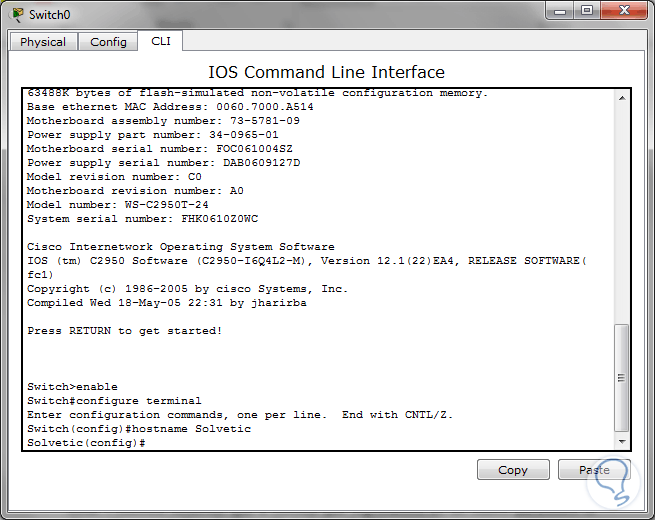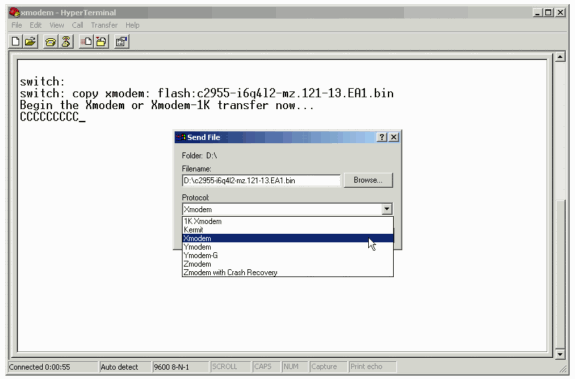Configuring Cisco router or switch: 1. To open HyperTerminal Click on Start. Then select programs followed by accessories. In communication section of Accessories, you will find HyperTerminal software. Enter desired name for the connection and click OK. Introduction Microsoft Hyperterminal is one of the most commonly used terminal emulator programs. This document explains how to use some Hyperterminal features with Cisco routers.
This chapter provides information and commands concerning the following topics:
• Boot system commands
• The Cisco IOS File System
• Backing up configurations to a TFTP server
• Restoring configurations from a TFTP server
• Backing up the Cisco IOS Software to a TFTP server
• Restoring/upgrading the Cisco IOS Software from a TFTP server
• Restoring the Cisco IOS Software from ROM Monitor mode using Xmodem

• Restoring the Cisco IOS Software using the ROM Monitor environmental variables and tftpdnld command
Boot System Commands
Router(config)#boot system flash imagename | Loads the Cisco IOS Software with image-name. |
Router(config)#boot system tftp image-name 172.16.10.3 | Loads the Cisco IOS Software with image-name from a TFTP server. |
Router(config)#boot system rom | Loads the Cisco IOS Software from ROM. |
Router(config)#exit | |
Router#copy running-config startup-config | Saves the running configuration to NVRAM. The router will execute commands in their order on the next reload. |
If you enter boot system flash first, that is the first place the router will go to look for the Cisco IOS Software. If you want to go to a TFTP server first, make sure that the boot system tftp command is the first one you enter.
The Cisco IOS File System
NOTE: The Cisco IOS File System (IFS) provides a single interface to all the file systems available on a routing device, including the flash memory file system; network file systems such as TFTP, Remote Copy Protocol (RCP), and File Transfer Protocol (FTP); and any other endpoint for reading and writing data, such as NVRAM, or the running configuration.
The Cisco IFS minimizes the required prompting for many commands. Instead of entering in an EXEC-level copy command and then having the system prompt you for more information, you can enter a single command on one line with all necessary information.
Cisco IOS Software Commands | IFS Commands |
copy tftp running-config | copy tftp: system:running-config |
copy tftp: nvram:startup-config | |
more nvram:startup-config | |
erase startup-config | erase nvram: |
copy running-config startup-config | copy system:running-config nvram:startup-config |
copy system:running-config tftp: | |
show running-config | more system:running-config |

Backing Up Configurations to a TFTP Server
Denver#copy running-config startup-config | Saves the running configuration from DRAM to NVRAM (locally). |
Denver#copy running-config tftp | Copies the running configuration to the remote TFTP server. |
Address or name of remote host[ ]? 192.168.119.20 | The IP address of the TFTP server. |
Destination Filename [Denver-confg]?®Entsr| | The name to use for the file saved on the TFTP server. |
iiiiiiiiiiiiiii | Each bang symbol (!) = 1 datagram of data. |
624 bytes copied in 7.05 secs | |
Denver# | File has been transferred successfully. |
NOTE: You can also use the preceding sequence for a copy startup-config tftp command sequence. | |
Restoring Configurations from a TFTP Server | |
Denver#copy tftp running-config | Copies the configuration file from the TFTP server to DRAM. |
Address or name of remote host[ ]? 192.168.119.20 | The IP address of the TFTP server. |
Source filename [ ]?Denver-confg | Enter the name of the file you want to retrieve. |
Destination filename [running-config]? ®Entsrl | |
Accessing tftp://192.168.119.20/Denver-confg... | |
Loading Denver-confg from 192.168.119.02 (via Fast Ethernet 0/0): | |
iiiiiiiiiiiiii | |
[OK-624 bytes] | |
624 bytes copied in 9.45 secs | |
Denver# | File has been transferred successfully. |
NOTE: You can also use the preceding sequence for a copy tftp startup-config command sequence.
Backing Up the Cisco IOS Software to a TFTP Server
Denver#copy flash tftp | |
Source filename [ ]? c2600-js-l_121-3.bin | Name of the Cisco IOS Software image. |
Address or name of remote host [ ]? 192.168.119.20 | The address of the TFTP server. |
Destination filename [c2600-js-l_121-3.bin]? (Enter! | The destination filename is the same as the source filename, so just press f Enter]. |
llllllllllllllllllllllllllllllllllllllllllllll | |
llllllllllllllllllllllllllllllllllllll | |
8906589 bytes copied in 263.68 seconds | |
Denver# |
Restoring/Upgrading the Cisco IOS Software from a TFTP Server
Denver#copy tftp flash | |
Address or name of remote host [ ]? 192.168.119.20 | |
Source filename [ ]? c2600-js-l_121-3.bin | |
Destination filename [c2600-js-l_121-3.bin]? | |
Accessing tftp://192.168.119.20/c2600-js-l_121-3.bin | |
Erase flash: before copying? [confirm] ( | If flash memory is full, erase it first. |
Erasing the flash file system will remove all files | |
Continue? [confirm] (Enter! | Press S-C if you want to cancel. |
Erasing device eeeeeeeeeeeeeeeeee...erased | Each e represents data being erased. |
Loading c2600-js-l_121-3.bin from 192.168.119.20 | |
(via) FastEthernet 0/0): iiiiiiiiiiiiiiiiiiiiiiiiiiiiiiiiiiiiiiiiiiii | Each bang symbol (!) = 1 datagram of data. |
iiiiiiiiiiiiiiiiiiiiiiiiiiiiiiiiiiiiiiiiiiii | |
!!! | |
Verifying Check sum OK | |
[OK - 8906589 Bytes] | |
8906589 bytes copied in 277.45 sees | |
Denver# | Success. |
Restoring the Cisco IOS Software from ROM Monitor Mode Using Xmodem
The output that follows was taken from a 1720 router. Some of this output might vary from yours, depending on the router model that you are using.
rommon 1 >confreg | Shows the configuration summary. Step through the questions, answering defaults until you can change the console baud rate. Change it to 115200; it makes transfer go faster. |
Configuration Summary enabled are: load rom after netboot fails console baud: 9600 boot: image specified by the boot system commands or default to: cisco2-c1700 |
do you wish to change the configuration? y/n [n]: y enable 'diagnostic mode'? y/n [n]: n enable 'use net in IP bcast address'? y/n [n]: n disable 'load rom after netboot fails'? y/n [n]: n enable 'use all zero broadcast'? y/n [n]: n enable 'break/abort has effect'? y/n [n]: n enable 'ignore system config info'? y/n [n]: n change console baud rate? y/n [n]: y enter rate: 0=9600, 1=4800, 2=1200, 3=2400 change the boot characteristics? y/n [n]: n | Prompts begin to ask a series of questions that allow you to change the configuration register. Answer n to all questions except the one that asks you to change the console baud rate. For the enter rate, choose 7 because that is the number that represents a baud rate of 115200. |
Configuration Summary enabled are: load rom after netboot fails console baud: 115200 boot: image specified by the boot system commands or default to: cisco2-c1700 do you wish to change the configuration? y/n [n]: n rommon2> | After the summary is shown again, choose n to not change the configuration and go to the rommon> prompt again. |
rommon 2>reset | Reloads the router at the new com speed. Change the HyperTerminal setting to 115200 to match the router's new console setting. |
Rommon 1>xmodem c1700-js-l_121-3.bin | Asking to transfer this image using Xmodem. |
...<output cut>... |
Do you wish to continue? y/n [n ]:y | Choose y to continue. |
In HyperTerminal, go to Transfer, then Send File (see Figure 16-1). Locate the Cisco IOS Software file on the hard drive and click Send (see Figure 16-2). | |
Router will reload when transfer is completed. | |
Reset baud rate on router. | |
Router(config)#line con 0 | |
Router(config-line)#speed 9600 | |
Router(config-line)#exit | HyperTerminal will stop responding. Reconnect to the router using 9600 baud, 8-N-1. |
Figure 16-1 Finding the Cisco IOS Software Image File
Figure 16-1 Finding the Cisco IOS Software Image File
Cisco Hyperterminal Software Update
Figure 16-2 Sending the Cisco IOS Software Image File to the Router
■ Send File E® | |
Folder C:DccumertsandSeitrgsDad | |
Fienare: | |
|c iosc17Ü0-y-mz.120-1XM | 1 Browe, ] |
Piotocol; | |
1 Zmodem wilh Ciwh Ftecovefy | Ml |
Restoring the Cisco IOS Software Using the ROM Monitor Environmental Variables and tftpdnld Command
rommon 1>IP_ADDRESS=192.168.100.1 | Indicates the IP address for this unit. |
rommon 2>IP_SUBNET_MASK=255.255.255.0 | Indicates the subnet mask for this unit. |
rommon 3>DEFAULT_GATEWAY=192.168.100.1 | Indicates the default gateway for this unit. |
rommon 4>TFTP_SERVER=192.168.100.2 | Indicates the IP address of the TFTP server. |
rommon 5>TFTP_FILE= c2600-js-l_121-3.bin | Indicates the filename to fetch from the TFTP server. |
rommon 6>tftpdnld | Starts the process. |
...<output cut>... | |
Do you wish to continue? y/n: [n]:y | |
...<output cut>... | |
Rommon 7>i | Resets the router. The i stands for initialize. |
NOTE: Commands and environmental variables are case sensitive, so be sure that you have not accidentally added spaces between variables and answers.
chapter 17
Continue reading here: Password Recovery Procedures and the Configuration Register
Was this article helpful?
How to Upgrade a Cisco 1841 IOS
The Cisco 1841 router can provide reliable service for years without a software upgrade. However, periodically Cisco releases an updated IOS with security and defect fixes that help ensure continued proper operation and performance. An IOS upgrade of the Cisco 1841 router can be performed in about 15 minutes.
Instructions
1. Connect one end of the serial console cable into the 9-pin serial port on the Windows XP computer, then connect the other end of the cable into the Cisco 1841 serial console port.
2Click the “Start” button on the XP computer, then click the “Run” box, type “hypertrm” and press the “Enter” key. The “HyperTerminal” application will appear.
3Type a name for the “HyperTerminal” connection in the “Name:” field presented in the first window, then press the “Enter” key. Click “Connect using:” In the drop-down menu that appears, select the “Com port” that connects the computer to the Cisco 1841 router, then tap the “Enter” key.
4Click “Bits per second:” and select the “9600” setting from the list that appears. Click “Flow Control” then the “None” setting in the list that appears, then press the “Enter” key.
5Tap the “Enter” key and the Cisco command line interface (CLI) will appear. Type the console port password if requested, then tap the “Enter” key.
6
Type “enable” and tap the “Enter” key, then type the Privileged Exec password and tap the “Enter” key.
7Enter “show flash” on the command line and tap the “Enter” key. If the “sdm.tar” file is listed in the command line output, then type “delete flash:sdm.tar” and tap the “Enter” key, then tap the “Enter” key again to confirm that you wish to delete the “sdm.tar” file. If the “sdm.tar” file is not listed, then proceed to the next step.
8Type “show flash” on the command line and tap the “Enter” key. Note the name of the IOS image file that is displayed in the command line output.
9Type “delete IOS_file” but replace the “IOS_file” with the exact name of the IOS image file that was displayed in the earlier command line output. Press the “Enter” key to confirm that you wish to delete the file.
10Type “copy tftp flash” on the command line, and tap the “Enter” key.
Hyperterminal Download
11Enter the IP address of the XP computer that has the TFTP service installed, then tap the “Enter” key.
12Enter the name of the IOS file that will be used to update the Cisco 1841 router, then tap the “Enter” key.
Technology Support Page
13
Enter the name of the IOS file again to confirm the filename, then tap the “Enter” key. The IOS image file will copy from the Windows XP TFTP service to the Cisco 1841 router.
14
Type “reload” at the command prompt to restart the router and run the new IOS image.